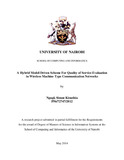| dc.description.abstract | In the very recent past, it has become increasingly clear that the next revolution in technology will be anchored on the phenomenon of the Internet of Everything (IoT), where every inanimate object has the potential to be connected to other objects in a network. Machine to Machine (M2M) communications is the base building block of the Internet of Things paradigm, and as such, it is expected that consumers will be heavily dependent on these networks at every strata of their lives, such that their interactions with their connected devices will become ubiquitous. The performance of these networks is of paramount importance to the consumer and service provider, with the consumer increasingly becoming involved in the performance deliberations. With the huge amounts of monitoring data generated from these networks, a suitable mechanism for evaluating the quality of service of these networks becomes an absolute necessity.
An effective and simple method of evaluating the performance would be to use objective QoS parameters measured from a network and characterize them into categories that would allow a consumer to subjectively evaluate them from the direct impact they are having on the consumer’s experience of the network. In this research, such a method is proposed in the form a two stage model that makes up an evaluation scheme for area networks in machine type communications. The first step uses measured QoS metrics that are fed into a Fuzzy Logic System (FLS) to obtain single output values of different QoS categories that linguistically describe aspects of the performance of a network. These are then used as inputs in a second Analytic Hierarchy Process (AHP) based stage that allows a user to incorporate subjective criteria such as intuition and general observation, to finally arrive at an overall QoS value. The measured network is simulated from Castalia, a Wireless Sensor Network (WSN) and low power embedded devices simulator based on the OMNeT++ platform. The network is a small six node WSN using the IEEE 802.15.4 standard. The FLS is realized in Matlab’s Fuzzy Logic Toolbox while the AHP step is done using Microsoft Excel’s logic module. From the results, our model is able to show an overall QoS of Good for the simulated network as well as point to network areas that might potentially lead to QoS deterioration and might need improvements. The model compares favorably with other models that implement Fuzzy Logic and Artificial Intelligence methods for QoS Evaluation. That it incorporates subjectivity in the evaluation is a novel feature that makes the scheme more versatile compared to other QoS evaluation models | en_US |

